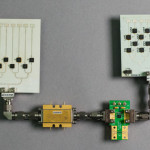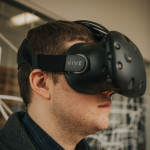
WHY THIS MATTERS IN BRIEF
- Consumers love convenience and by helping to cut the chords on VR headsets MIT’s new breakthrough could help speed up the technology’s adoption
Researchers from MIT’s Computer Science and Artificial Intelligence Laboratory (CSAIL) have developed a new technology that lets data be transmitted at much higher speeds than today’s off the shelf WiFi products and the technology could be used to help virtual reality headset manufacturers cut the chords.
Current virtual reality headsets have to be tethered to a computer because using todays wireless technology it’s pretty much impossible to stream 3D video. There’s just too much data to get across. But hooking up a VR headset to a computer makes it difficult to use VR with any sort of freedom, and creates a tripping hazard if you’re trying to walk around. It’s a hard life…
Some companies, like MSI, have tried to get around the problem by creating a backpack computer but needless to say it’s expensive, bulky and only works for one person at a time.
MIT’s solution was to use something called Millimeter Wave Wireless Technology (MWWT). Millimeter waves are like the radio waves used in WiFi technology, but are higher frequency and the higher frequency of millimeter waves means they can transmit more information, which makes them well suited for VR.
However, there’s a problem. Unlike radio waves, which pass through people and walls as they travel from transmitter to receiver, millimeter waves can be blocked. In a VR setup, this means that if the user turns around or puts their hand in front of the headset, the connection can be interrupted.
To get around this problem, the researchers developed a new technology, called MoVR, that can reflect and redirect millimeter waves so they reach the VR headset no matter what’s in the way.
MoVR detects incoming millimeter waves from a transmitter, and uses two directional antennae to reflect it toward the receiver. MoVR is accurate to within 2 degrees, and can redirect waves within a fraction of a second for uninterrupted transmission.
The system was tested with an HTC Vive, but the researchers say it can work with any VR headset. Their next step is to shrink the device so that it’s the same size as a smartphone, and then you might be able to play your VR games without worrying about tripping over cables.


















